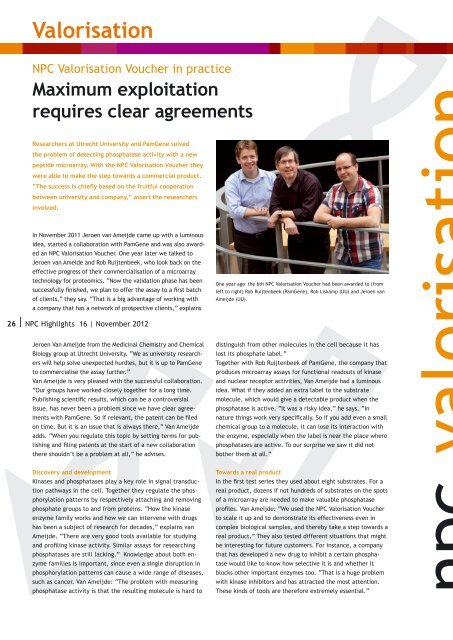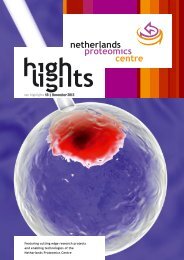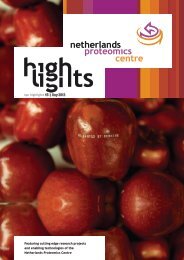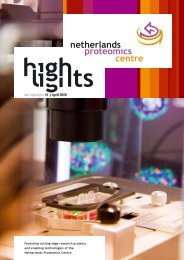NPC Valorisation Voucher - Netherlands Proteomics Centre
NPC Valorisation Voucher - Netherlands Proteomics Centre
NPC Valorisation Voucher - Netherlands Proteomics Centre
You also want an ePaper? Increase the reach of your titles
YUMPU automatically turns print PDFs into web optimized ePapers that Google loves.
<strong>Valorisation</strong><strong>NPC</strong> <strong>Valorisation</strong> <strong>Voucher</strong> in practiceMaximum exploitationrequires clear agreementsResearchers at Utrecht University and PamGene solvedthe problem of detecting phosphatase activity with a newpeptide microarray. With the <strong>NPC</strong> <strong>Valorisation</strong> <strong>Voucher</strong> theywere able to make the step towards a commercial product.“The success is chiefly based on the fruitful cooperationbetween university and company,” assert the researchersinvolved.In November 2011 Jeroen van Ameijde came up with a luminousidea, started a collaboration with PamGene and was also awardedan <strong>NPC</strong> <strong>Valorisation</strong> <strong>Voucher</strong>. One year later we talked toJeroen van Ameide and Rob Ruijtenbeek, who look back on theeffective progress of their commercialisation of a microarraytechnology for proteomics. “Now the validation phase has beensuccessfully finished, we plan to offer the assay to a first batchof clients,” they say. “That is a big advantage of working witha company that has a network of prospective clients,” explainsOne year ago the 6th <strong>NPC</strong> <strong>Valorisation</strong> <strong>Voucher</strong> had been awarded to (fromleft to right) Rob Ruijtenbeek (PamGene), Rob Liskamp (UU) and Jeroen vanAmeijde (UU).26 | <strong>NPC</strong> Highlights 16 | November 2012Jeroen Van Ameijde from the Medicinal Chemistry and ChemicalBiology group at Utrecht University. “We as university researcherswill help solve unexpected hurdles, but it is up to PamGeneto commercialise the assay further.”Van Ameijde is very pleased with the successful collaboration.“Our groups have worked closely together for a long time.Publishing scientific results, which can be a controversialissue, has never been a problem since we have clear agreementswith PamGene. So if relevant, the patent can be filedon time. But it is an issue that is always there,” Van Ameijdeadds. “When you regulate this topic by setting terms for publishingand filing patents at the start of a new collaborationthere shouldn’t be a problem at all,” he advises.distinguish from other molecules in the cell because it haslost its phosphate label.”Together with Rob Ruijtenbeek of PamGene, the company thatproduces microarray assays for functional readouts of kinaseand nuclear receptor activities, Van Ameijde had a luminousidea. What if they added an extra label to the substratemolecule, which would give a detectable product when thephosphatase is active. “It was a risky idea,” he says. “Innature things work very specifically. So if you add even a smallchemical group to a molecule, it can lose its interaction withthe enzyme, especially when the label is near the place wherephosphatases are active. To our surprise we saw it did notbother them at all.”Discovery and developmentKinases and phosphatases play a key role in signal transductionpathways in the cell. Together they regulate the phosphorylationpatterns by respectively attaching and removingphosphate groups to and from proteins. “How the kinaseenzyme family works and how we can intervene with drugshas been a subject of research for decades,” explains vanAmeijde. “There are very good tools available for studyingand profiling kinase activity. Similar assays for researchingphosphatases are still lacking.” Knowledge about both enzymefamilies is important, since even a single disruption inphosphorylation patterns can cause a wide range of diseases,such as cancer. Van Ameijde: “The problem with measuringphosphatase activity is that the resulting molecule is hard toTowards a real productIn the first test series they used about eight substrates. For areal product, dozens if not hundreds of substrates on the spotsof a microarray are needed to make valuable phosphataseprofiles. Van Ameijde: “We used the <strong>NPC</strong> <strong>Valorisation</strong> <strong>Voucher</strong>to scale it up and to demonstrate its effectiveness even incomplex biological samples, and thereby take a step towards areal product.” They also tested different situations that mightbe interesting for future customers. For instance, a companythat has developed a new drug to inhibit a certain phosphatasewould like to know how selective it is and whether itblocks other important enzymes too. “That is a huge problemwith kinase inhibitors and has attracted the most attention.These kinds of tools are therefore extremely essential.”






